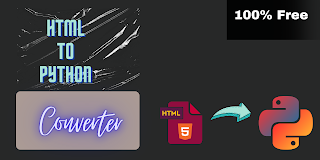HTML to Python Converter Tool
Convert your HTML code to Python in just a few clicks!
Enter HTML Code
Python Output
 |
| HTML To Python |
**Title: HTML to Python Converter: A Comprehensive User Guide**
---
### Introduction
In today's digital age, where programming languages serve as the backbone of web development and automation tasks, the ability to seamlessly convert between different formats is invaluable. One such conversion often required is transforming HTML code into Python strings. Whether you're a developer, data scientist, or automation enthusiast, having a reliable HTML to Python Converter can save time and streamline workflows. In this blog post, we'll explore what an HTML to Python Converter is, its importance, and how to effectively use one.
### What is an HTML to Python Converter?
An HTML to Python Converter is a tool designed to translate HTML code into Python string format. This conversion is crucial for developers who need to integrate HTML snippets into Python scripts or applications seamlessly. The converter preserves the structure, tags, and attributes of the HTML code while adapting it into a Python-compatible format, ensuring that the content remains intact and functional.
### Importance of HTML to Python Conversion
1. **Integration and Automation**: Integrating HTML content directly into Python scripts allows for dynamic content generation, web scraping, and automation tasks.
2. **Code Reusability**: Converting HTML into Python strings facilitates code reusability across different platforms and applications.
3. **Data Extraction**: For data scientists and analysts, converting HTML tables or structured content into Python strings enables easy extraction, manipulation, and analysis of data.
### How to Use an HTML to Python Converter
#### Step 1: Access the Converter Tool
You can find various HTML to Python Converter tools online or build one using JavaScript for frontend and Python for backend conversion. Here, we'll focus on using a frontend JavaScript-based converter for simplicity.
#### Step 2: Paste Your HTML Code
- Navigate to the HTML to Python Converter tool.
- You'll typically find an input box or textarea labeled "Paste your HTML code here." This is where you'll paste your HTML snippet that you wish to convert.
#### Step 3: Click "Convert to Python"
- After pasting your HTML code, click on the "Convert to Python" button or similar action trigger provided by the tool.
- The converter will process your HTML code and transform it into Python string format.
#### Step 4: Review and Copy the Python Code
- Once the conversion is complete, the Python string representation of your HTML code will be displayed.
- Review the Python code to ensure it accurately represents your HTML structure and content.
- Click on the "Copy Code" button (if available) to copy the Python code to your clipboard for use in your Python scripts or applications.
### Example Use Case
Imagine you have an HTML webpage with structured content, including headings, paragraphs, and links. Using an HTML to Python Converter, you can easily transform this HTML content into Python strings. For instance:
```python
html_content = """
<div id="main-content">
<h2>Welcome to HTML to Python Converter</h2>
<p>This is a sample HTML code that you can use to test the converter tool.</p>
<ul>
<li><a href="#section1">Section 1</a></li>
<li><a href="#section2">Section 2</a></li>
<li><a href="#section3">Section 3</a></li>
</ul>
<section id="section1">
<h3>Section 1 Content</h3>
<p>This is the content of section 1.</p>
</section>
<section id="section2">
<h3>Section 2 Content</h3>
<p>This is the content of section 2.</p>
</section>
<section id="section3">
<h3>Section 3 Content</h3>
<p>This is the content of section 3.</p>
</section>
</div>
"""
```
### Conclusion
In conclusion, an HTML to Python Converter simplifies the process of converting HTML code into Python strings, offering developers and data professionals a convenient way to integrate web content into Python applications. By following the steps outlined in this guide, you can effectively use a converter tool to streamline your workflow, enhance code reusability, and leverage HTML content for various automation and data manipulation tasks in Python.
Next time you encounter the need to convert HTML to Python, remember the efficiency and convenience that an HTML to Python Converter brings to your development toolkit.
---
By understanding and utilizing an HTML to Python Converter effectively, developers and professionals can bridge the gap between web content and Python applications, enhancing productivity and enabling seamless integration of HTML data into Python workflows.










